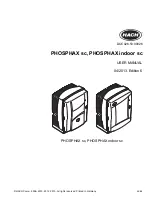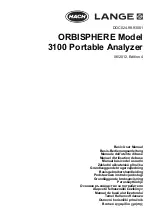
Analysis
40
make the CS-2000 very sensitive in carbon. The limits are set by the air entering the resistance
furnace and by the blanks of the boats. Good results can be obtained by using quartz boats.
There is no chance to measure in this low range if you use ceramic boats. Their blanks and
their deviations are huge compared to the sample’s carbon.
Even without using any low carbon attachment for preventing the air from entering the furnace,
it is possible to obtain acceptable results in the 50ppm range.
A PC should be connected so that the base line and the peaks of combustion can be seen. First
thing to do is to check the base line. The blank value should be set to zero and the analyzer
should be calibrated with a higher sample so that the calibration factor is at least in a correct
range.
Enter manually a usual sample weight taken for low carbon analysis, i.e. about 1000mg. Start
the analysis cycle without entering sample or boat into the furnace. Repeat this 3 to 5 times.
This way you know what is the reading caused by the air entering the furnace as well as by the
base line drift and noise. So, when you run analyses later on, any higher value comes from
sample and boat.
Of course the boats themselves can also be tested without sample: Enter manually 1000mg,
press START and enter empty boats. The difference of the results to those without boat, give
evidence about the blanks of the boats. These blanks and their deviations must be much lower
than the expected sample results and much lower than the expected sample deviations,
otherwise an analysis doesn’t make any sense.
For even lower carbon samples, a low carbon attachment needs to be attached to the
resistance furnace inlet. See following graphic.
The reason is that the thick short combustion tube allows some air to enter the combustion
area. The air contains some CO2 which is detected by the carbon cell. As the CO2
concentration resp. the air flow entering the furnace is not necessarily constant, the varying
CO2 of the air will lead to a corresponding variations of the base line. Using high carbon
analysis in % range, resp. for high carbon IR-cells, the CO2 of the entering air, practically
doesn’t have any influence on the results. For low carbon analysis, with sensitive CO2 cells, the
entrance of the resistance furnace has to be restricted in order to have less air entering the
furnace.
The combustion boats that are used are the slim quartz boats. They have to be used, not only
because the bigger ceramic boats can
’t pass through the restriction attachment, but also
because the quartz boats have much lower blanks than the ceramic boats.
Even if the ceramic boats were able to pass through the attachment, they couldn’t be used for
low carbon analysis anyway, because of their high carbon blanks.
Operation procedure:
1.
Check the base line. (The blank value should be set to zero and the analyzer should be
calibrated with a higher sample so that the calibration factor is at least in a correct range.)
2.
Enter manually a usual sample weight taken for low carbon analysis, i.e. about 500mg.
3.
Start the analysis cycle without entering sample or boat into the furnace.
4.
Repeat this 3 to 5 times. This way you know which influence is caused by the air entering
the furnace as well as by the base line drift and noise. So, when you run analyses later
on, any higher value comes from the sample and boat.
Of course the boats themselves can also be tested without sample:
1.
Enter manually 500mg.
2.
Press START.
3.
Enter an empty boat.
The difference of the results to those without boat gives evidence about the blanks of the boats.
These blanks and their deviations must be much lower than the expected sample results and
much lower than the expected sample deviations, otherwise an analysis doesn't make any
sense.
Содержание CS-2000
Страница 2: ...2 Copyright Copyright by Eltra GmbH Retsch Allee 1 5 42781 Haan Germany ...
Страница 5: ...5 ...
Страница 63: ...Maintenance 63 Fig 35 Induction furnace Cone ...
Страница 80: ...Function description 80 Fig 51 Gas flow system ...
Страница 91: ...Miscellaneous 91 8 1 6 Furnace Fig 60 Furnace 71031 71010 ...
Страница 98: ...Miscellaneous 98 8 1 12 Tic module Fig 66 TIC module 35543 9008 1 2 3 4 5 6 7 8 9 10 11 12 13 14 15 16 17 ...
Страница 110: ...Copyright Copyright by Eltra GmbH Retsch Allee 1 5 42781 Haan Germany ...
















































